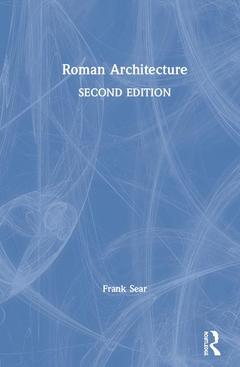Description
Roman Architecture (2nd Ed.)
Author: Sear Frank
Language: English
Subjects for Roman Architecture:
Keywords
Scaenae Frons; Brick Faced Concrete; roman architecture; Roman Feet; republican architecture; NE Side; republican rome; Lepcis Magna; republican buildings; NW Side; roman buildings; Colonnaded Street; augustan architecture; Forum Julium; augustan rome; roman building types; Opus Incertum; julio-claudian architecture; Fourth Century Ad; julio-claudian rome; Opus Reticulatum; pompeii; Stabian Baths; pompeiian architecture; Domus Tiberiana; ostia; Giallo Antico; flavian rome; Augusta Raurica; flavian architecture; Curia Hostilia; roman north africa; Domical Vault; architecture in roman north africa; Septimius Severus; late antique roman architecture; Ad Theatre; roman architecture in europe; Campus Martius; roman building in architecture; Minerva Medica; architecture in the eastern provinces; Flavian Palace; roman building in the eastern provinces; SE Side; roman architecture in the east; De Arch; roman buildings in the east; roman architects; roman building materials; roman building techniques; Roman Empire; Age of Augustus; Roman's architecture
Approximative price 160.25 €
In Print (Delivery period: 14 days).
Add to cartPublication date: 07-2020
· 17.4x24.6 cm · Hardback
Publication date: 07-2020
· 17.4x24.6 cm · Paperback
Description
/li>Contents
/li>Biography
/li>
In this fully updated new edition, Frank Sear offers a thorough overview of the history of architecture in the Roman Empire.
Arranged logically in six historical sections interspersed with material on Roman architects and their techniques, the building types found in Roman cities and the different buildings found in the Roman provinces, this volume now contains the latest insights into Roman architecture and takes account of the past 20 years of scholarship. This seminal work covers the architecture of the Republic, the Age of Augustus, the imperial period, Pompeii and Ostia, the eastern and western empire, and the Late Antique period, exploring subjects such as patronage, building techniques and materials, Roman engineering, town planning and imperial propaganda in a concise and readable way.
Illustrated with nearly 300 photographs, maps and drawings, Roman Architecture continues to be the clearest introductory account of the development of architecture in the Roman Empire.
1. Republican Rome 2. Roman Building Types 3. The Age of Augustus 4. Roman Architects, Building Techniques and Materials 5. The Julio-Claudians 6. Two Roman Towns: Pompeii and Ostia 7. The Flavians 8. Trajan and Hadrian 9. North Africa 10. The European Provinces 11. The Eastern Provinces 12. The Late Empire
Frank Sear is a graduate of Cambridge University, where he did both his undergraduate and postgraduate work. As a Scholar at the British School he did research on Roman Wall and Vault Mosaics, and as a Cotton Fellow he excavated in Benghazi and Lepcis Magna, Libya. In 1975 he took up a lecturing position at the University of Adelaide where he taught Latin, Greek and Classical Archaeology. He has since been a visiting scholar at the German Archaeological Institute in Berlin, a Fellow of Corpus Christi College, Oxford, and Hugh Last Fellow at the British School at Rome. He is also a Fellow of the Society of Antiquaries of London and a Fellow of the Australian Academy of the Humanities. He was Professor of Classical Studies at the University of Melbourne from 1991 to 2009 and is now Professor Emeritus. He was the co-director of the Australian Pompeii project from 1978 to 1988, and since 1990 has directed the Australian Roman Theatres project, surveying the theatres at Gubbio, Taormina, Benevento and Pompeii in Italy; Jerash in Jordan; and Orange in France. He has written numerous articles on his archaeological work and published a number of books including Roman Wall and Vault Mosaics, Roman Architecture and Roman Theatres.




